PSEB Solutions for Class 9 Science Chapter 8 Motion
PSEB Solutions for Class 9 Science Chapter 8 Motion
PSEB 9th Class Science Solutions Chapter 8 Motion
→ A body is said to be in motion when it changes its position with time.
→ At any instant, a body may appear to be in motion to one person but the same object may appear at rest to another person.
→ To describe the position of an object we are required to fix the directive point which is called the origin.
→ The motion of some objects can be controlled while that of some other objects remains uncontrolled and irregular.
→ When an object moves along a straight line path then its motion is called linear motion.
→ Those quantities which can be described completely by their magnitude only are called physical quantities.
→ The shortest distance measured between initial and final position is called displacement of the body.
→ When the final position of the body in motion coincides with its initial position then the value of displacement becomes equal to zero.
→ The displacement of an object may be zero but its distance will not be zero.
→ An odometer is a device that measures the distance covered by automobiles.
→ The rate of change of motion of an object is called its speed. The unit of speed is ms-1.
→ The average speed of an object is obtained by dividing the distance covered by the body by the time taken to cover that distance.
∴ Average speed = Total distance covered/Time taken to cover that distance
→ The rate of change of motion of a body in a particular direction is called its velocity i.e. speed in a particular direction is called velocity.
→ Time interval is measured by digital wristwatch or stopwatch.
→ Speed of sound in air = 340 m/s.
→ Speed of light in air = 3 × 108 m/s.
→ The rate of change of velocity of a body is called its acceleration
- Acceleration = Change in velocity/Time taken
- S.I. unit of acceleration is ms-2.
→ If the velocity of an object changes by the same rate then its mean (average) velocity, is obtained by taking the arithmetic mean of initial velocity and final velocity.
∴ Average Velocity = Initial velocity + Final velocity/2
→ If an object covers equal distances in equal intervals of time however small the interval maybe then its motion is called uniform motion.
→ If a moving object covers unequal distances in equal intervals of time then the motion of the object is called non-uniform motion.
→ Rest: A body is said to be at rest if it does not change its position with respect to its surroundings.
→ Motion: A body is said to be in motion if it changes its position with time with respect to its surroundings.
→ Distance: It is the length of the actual path travelled by a body between its initial position and final position.
→ Displacement: Tire change in position of an object in a given direction is known as displacement. It is measured by the shortest distance moved by a body from the initial position to the final position.
→ Uniform Motion: If an object covers equal distances in equal intervals of time however small the time intervals may be, then the motion of the object is said to be uniform motion.
→ Non-Uniform Motion: If an object covers unequal distances in equal intervals of time then the object is said to be in non-uniform motion.
→ Speed: The distance travelled by a body in a unit of time
Speed = Distance traveled/Total time taken
→ Average Speed: It is the total distance travelled bv an object divided by the time taken to travel that distance.
Average speed = Total distance travelled/Total time taken
→ Uniform Velocity: If a body covers equal distances in equal intervals of time, however small these intervals maybe, in a particular direction its velocity is said to be uniform velocity.
→ Variable Velocity: If a body travels unequal distances in equal intervals of time or changes its direction or both then its velocity is said to be variable velocity.
→ Uniform Circular Motion: When a body moves along a circular path with uniform speed, its motion is called uniform circular motion. Tire motion is uniformly accelerated due to continuous change of direction.
→ Angular Velocity: It is the angle swept by the radius per unit time
ω = θ/t rad/s
→ Velocity: It is the displacement produced per unit time.
or
It is the distance travelled per unit time in a given direction.
Velocity = Displacement/Time
→ Uniform Speed: When an object covers equal distances in equal intervals of time, however small these intervals may be, it is said to move with uniform speed.
→ Non-Uniform Speed: When an object covers unequal distances in equal intervals of time, it is said to move with non-uniform speed.
PSEB 9th Class Science Important Questions Chapter 8 Motion
Long Answer Type Questions:
Question 1.
Derive mathematically the equations of motion.
Answer:
Equations of motion under uniform acceleration: The following are the equations of motion of an object moving in a straight line with uniform acceleration.
1. υ = u + at
2. S = ut + 1/2at2
3. υ2 – u2 = 2aS
1. First Equation of Motion, υ = u + at
Let u be the initial velocity and ‘a’ be the uniform acceleration of a body in motion so that after every 1 sec its velocity increases by ‘a’.
Increase in velocity of the body after 1 sec = a
Secondary Increase in velocity of the body after 2 sec = a + a = 2 a
∴ Increase in velocity after t sec = a × t = at
Therefore, velocity of an object after t secs = Initial velocity + increase in velocity of the object after ‘t’ secs
or υ = u + at
2. Second equation of motion S = ut + 1/2at2
Let ‘u’ be the initial velocity of the body in motion having uniform acceleration ‘a’ and after ‘t’ second the final velocity be ‘υ’.
∴ Increase in velocity of the body after 1sec = a
Velocity of the body after 1 sec from start of its motion = (u + a)
Velocity of the body 1 second before the end of its motion = (υ – a)


Question 2.
For uniform accelerated motion, draw by graphical method establish the following equations of motion:
1. υ = u + at
2. S = ut + 1/2at2
3. υ2 = u2 + 2aS
Answer:
Consider an object moving with initial velocity ‘u’ along a straight line and uniform acceleration ‘a’. Suppose its final velocity becomes υ after time t and during this time it travels a distance S. If time is represented along X-axis and velocity along Y-axis, then velocity-time graph obtained will be BA, an ipchned straight line. With its help we can derive the various equators of motion.
Here OA = ED = u,
OC = EB = υ and OE = t = AD
(a)Equation for velocity-time relation. We know that
Acceleration = Slope of velocity-time graph AB or
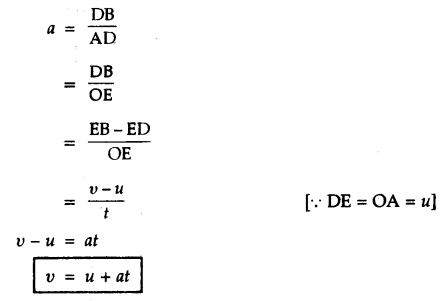
This proves the first equation of motion.
(b) Equation for position-time relation
We know that area below velocity-time graph and time axis gives the distance covered by the body.
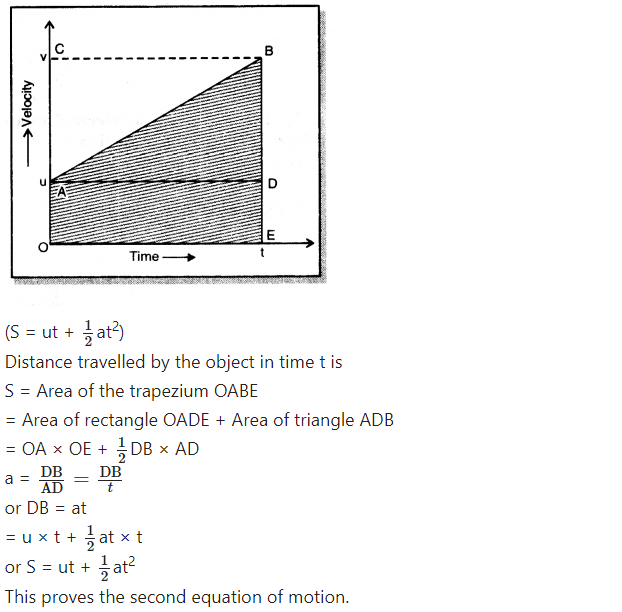
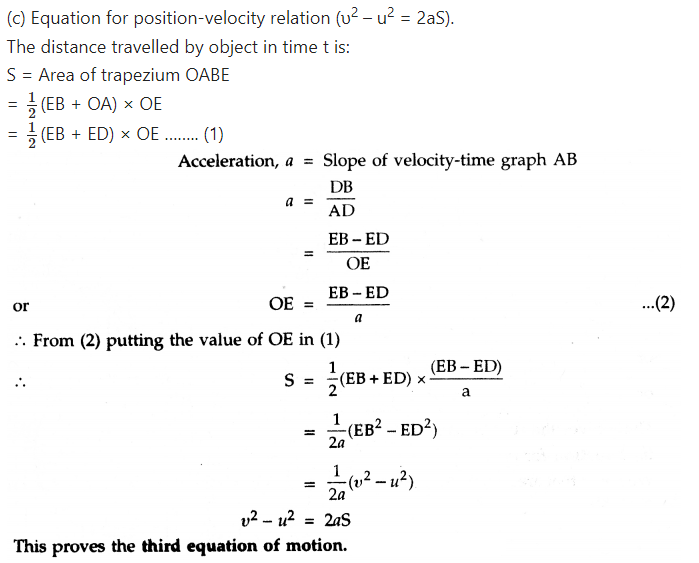
Question 3.
Draw velocity-time graph for a body moving with uniform velocity. Hence show that the area under the velocity-time graph gives the distance travelled by the body in a given time interval.
Answer:
Distance covered as area under the velocity-time graph. In Fig. straight line PQ is the velocity-time graph of a body moving with a uniform velocity, ‘υ’ represented by OP.
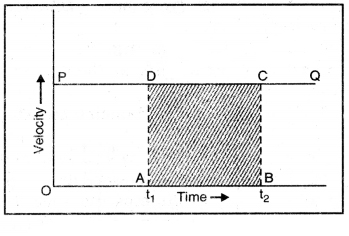
Area of rectangle ABCD
= AD × AB
= OP × AB
= υ × (t2 – t1)
= Velocity × time
= Distance travelled in time interval (t2 – t1)
Hence, the area under the velocity-time graph gives the distance travelled by the body in the given time interval.
Question 4.
What is meant by Angular velocity? How is it related to linear velocity? Derive the relation.
Answer:
Angular velocity: The angle traced out by a body moving along a circular path in unit time is called Angular velocity. It is usually represented by a greek letter ω (omega). If θ is the angle covered by a body in time ‘t’, then
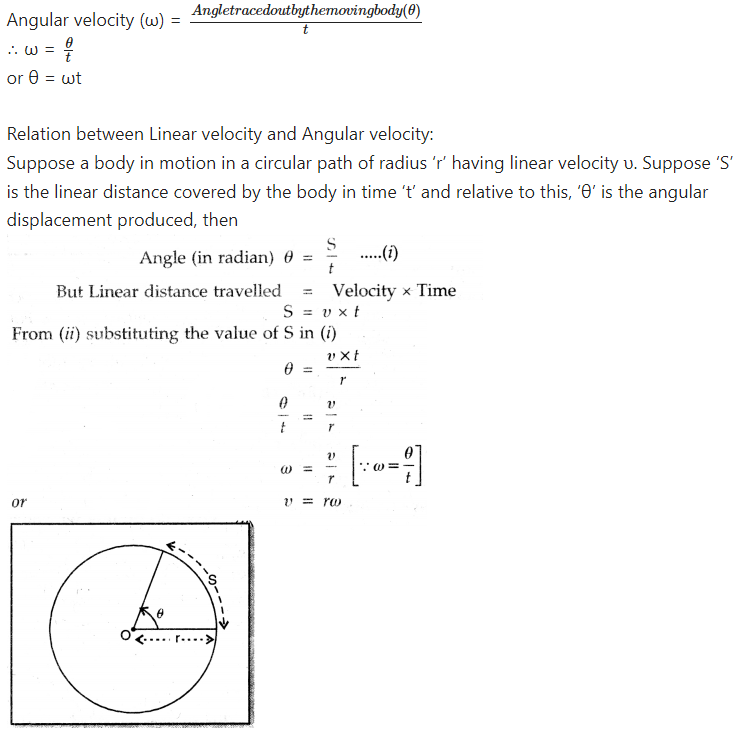
Short Answer Type Questions:
Question 1.
Define rest and motion. Give one example for each.
Answer:
- Rest: A body is said to be at rest if it does not change its position with respect to its surroundings. A book lying on the table in a room is at rest with respect to the other objects in the room.
- Motion: A body is said to be in motion if it changes its position with time with respect to its surroundings. A car running on the road is in motion with respect to the electricpole, trees along the roadside.
Question 2.
Show that rest and motion are relative terms.
Or
Can an object be af rest as well as in motion at the same time?
Answer:
An object may be at rest relative to one surrounding object and at the same time it may be in motion with respect to some other object. For example, a passenger sitting in moving train is at rest relative to other co-passengers. But since he is sharing the motion of the train, so he is in motion relative to the outside trees, lamp posts etc. Thus, rest and motion are relative terms.
Question 3.
Give some points of differences between distance and displacement.
Or
Give two differences between distance and displacement.
Answer:
Differences between distance and displacement:
| Distance | Displacement |
| 1. Distance is the length of the actual path covered by a body, irrespective of its direction of motion. | Displacement is the shortest distance between the initial and final positions of a body in a given direction. |
| 2. Distance between two given points may be same or different for different paths chosen. | Displacement between two given points is always same. |
| 3. It is a scalar quantity. | It is a vector quantity. |
| 4. Distance covered is always positive or zero. | Displacement covered may be positive, negative or zero. |
Question 4.
What is meant by uniform motion?Give an example.
Answer:
Uniform motion. If an object covers equal distances in equal intervals of time, hoxvever small the time interval may be, then the motion of the object is said to be uniform motion. For example, suppose a bus moves 10 km in the first 15 minutes, 10 km in second 15 minutes, 10 km in third 15 minutes and so on. Then one can say that the bus is in uniform motion.
Question 5.
Define the term velocity. What is its SI unit?Is it a scalar or vector quantity?
Answer:
Velocity: Velocity of a body is defined as the displacement produced per unit time. It is also defined as the speed of a body in a given direction.
Velocity = Displacement/Time
If ‘S’ is the distance travelled by a body in a given direction and t is the time taken to travel that distance, then the velocity ‘υ’ is given by
υ = S/t
The SI unit of velocity is m s-1.
Velocity is a vector quantity because it requires both magnitude and direction for its complete description.
Symbols of Physical Quantities and Important Formulae:
(A) Symbols of Physical Quantities
- Time = t
- Speed = v
- Distance = S
- Initial Velocity = u
- Final Velocity = v
- Acceleration = a
- Average Velocity = Vav
(B) Important Formulae:
If initial velocity u at time t velocity υ and uniform acceleration a Then the under given relations are called Equations motion:
υ = u + at (Velocity at time t)
S = ut + 1/2at2(Displacement in time ‘t’)
υ2 = u2 + 2aS (Velocity square relation)
Displacement in n th The Second of time (Sn) = u + (2n – 1)
Numerical Problems (Solved):
Question 1.
A police car running on a highway with a speed of 30 km/h fires on the vehicle of thiefs running in the same direction at a speed of 192 km/h. If the velocity of the bullet is 150 m/s then with what velocity the bullet will hit the thiefs?
Solution:
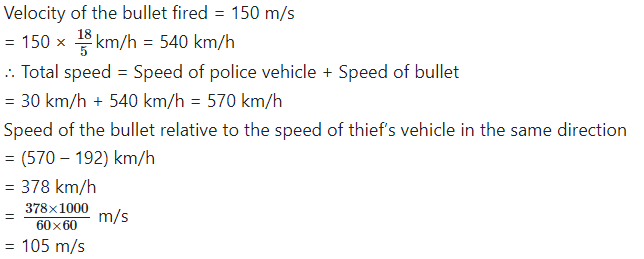
Question 2.
A train 50 m long travels on a plain and level track and reached a post in 5 secs. Find
1. speed of the train
2. the time train will take to cross 450 m long bridge.
Solution:
1. Since the train takes 5 secs to reach the post, it covers a distance equal to its own length, then
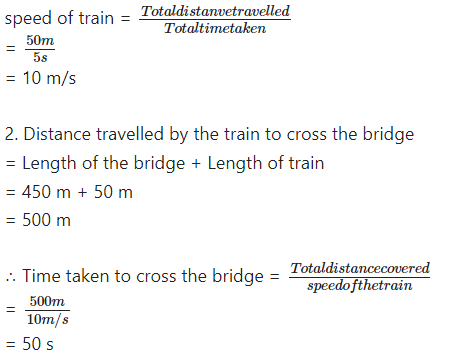
Question 3.
A cheetah is the fastest land animal and can achieve a peak velocity of 100 km/h upto distances less than 500 m. If a cheetah spots his prey at a distance of 100 m. What is the minimum time it will take to get its prey, if the average velocity attained by it is 90 km/h.
Solution:
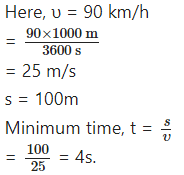
Question 4.
A car travels a certain distance with a speed of 50 km/h and returns with a speed of 40 km/h. Calculate the average speed for the whole journey.
Solution:
Let the one-way distance = x km

Question 5.
On a 100 km track, a train travels the first 30 km at a uniform speed of 30 km h-1. How fast must the train travel the next 70 km so as to average 40 km h-1 for the entire trip?
solution:
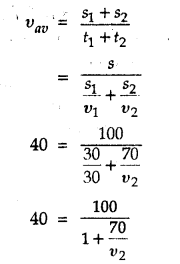
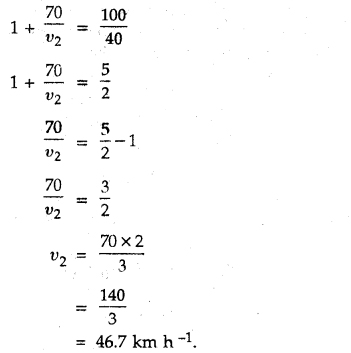
Question 6.
A railway train 50 m long passes over a bridge 250 m long with uniform velocity of 10 m s-1. How long will it take to completely, pass over the bridge?
Solution:

To completely pass over the bridge, the train will have to cover the length of the bridge, as well as its own length i.e., AB + BC
∴ Total distance to be covered, S = 50 + 250 = 300 m
Velocity of train, u = 10 m s-1
Here velocity is uniform, hence
a = 0 m s-2
Using S = ut + 1/2at2
300 = 10t + 0
or t = 30 s
Hence train will pass completely over the bridge in 30 s.
Question 7.
A car starts from rest and moves with uniform acceleration for 40 s. It then moves with uniform velocity attained by it and is finally brought to rest in 30 s under uniform retardation. The car covers a total distance of 1,380 m in 2.5 min. Calculate constant speed, acceleration and retardation.
Solution:
Let x be the constant speed. Now the total distance covered is equal to total area between velocity-time graph and time axis. Therefore
Distance covered = area of ∆ABC + area of rectangle BCDE + area of ADEF
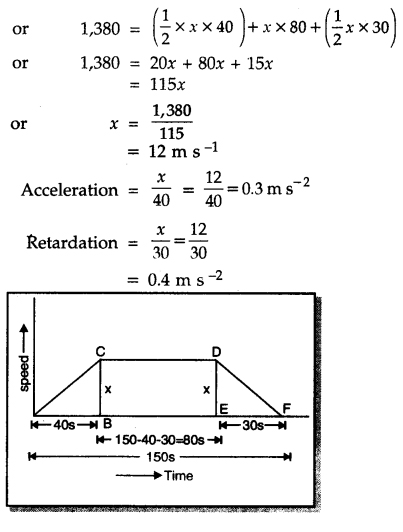
Question 8.
The graph shown in Fig. indicates the position of body at different positions. Calculate the speed of the body as it moves from (i) A to B; (ii) B to C and (iii) C to D.
Solution:
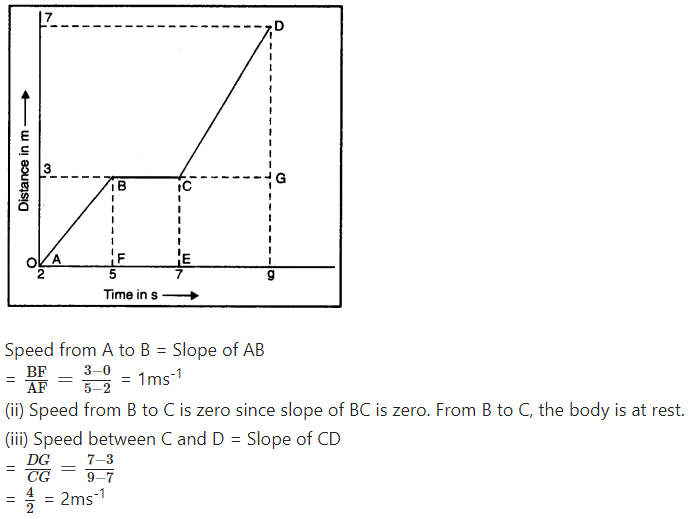
Very Short Answer Type Questions:
Question 1.
What is motion?
Answer:
Motion: When an object changes its position with time then it is said to be in motion.
Question 2.
What is displacement of object?
Answer:
Displacement. The change in position of an object in a given direction is known as displacement. It is measured by the shortest distance moved by an object from its initial position to final position.
Question 3.
Which device shows the speed of vehicles?
Answer:
Odometer.
Question 4.
What is uniform motion?
Answer:
Uniform motion. When a body covers equal distances in equal intervals of time then its motion is called uniform motion.
Question 5.
Give two examples of non-uniform motion.
Answer:
1. A car moving on the road.
2. A man doing exercise in park.
Question 6.
Define speed.
Answer:
Speed. The distance travelled by a body in a unit time is called its speed.
Question 7.
What is the SI unit of speed?
Answer:
S.I. unit of speed is ms-1.
Question 8.
How is average speed obtained?
Answer:
Average speed. It is the total distance travelled by an object divided by the time taken to travel that distance.
![]()
Question 9.
What is velocity?
Answer:
Velocity: The speed in a particular direction is called velocity.
Or
It is the distance travelled by an object in a particular direction.
Question 10.
What is acceleration?
Answer:
Acceleration. It is defined as the rate of change of velocity with time.
![]()
Question 11.
What is the SI unit of acceleration?
Answer:
ms-2
Question 12.
A cricket player tosses the ball upward and again catches it. What is the total displacement?
Answer:
Total displacement is zero.
Question 13.
Is displacement a scalar or vector quantity?
Answer:
Displacement is a vector quantity because it needs both magnitude and direction for its complete representation.
Question 14.
What would be acceleration of a body if its velocity-time graph is line parallel to the time axis?
Answer:
Zero, as the body possesses uniform velocity.
Question 15.
A body is moving along the boundary of a square plot of land with constant speed. Does its velocity remain unchanged?
Answer:
No. because its velocity changes due to change in direction.
Question 16.
What will be the position-time graph of a city bus standing at rest at a depot?
Answer:
A straight line parallel to the time axis.
Question 17.
What is the nature of the distance-time graph for an object moving uniformly along a straight long road?
Answer:
A straight line inclined to the time axis.
Question 18.
Does the speedometer of a car measure its average speed?
Answer:
No. It measures only instantaneous speed.
Science Guide for Class 9 PSEB Motion InText Questions and Answers
Question 1.
An object has moved through a distance. Can it have zero displacements? If yes,support your answer with an example.
Answer:
Yes, a body can have zero displacement, if fhis body While moving occupies its final position coinciding with its initial position.
Example: Suppose a body starting its motion from initial position O covers some distance and reaches a position A. If this body while moving returns to its initial position O then in that situation its displacement will be zero.

But distance covered by the body = OA + AO
= 60 km + 60 km
= 120 km
Question 2.
A farmer moves along the boundary of a square field of side 10 m in 40 s. What will be the magnitude of displacement of the farmer at the end of 2 minutes 20 seconds?
Solution:
Total distance round the boundary of field once (i.e. circumference)
= AB + BC + CD + DA
= 10 m + 10 m + 10 m + 10 m = 40 m
Time taken to go round the field once = 40 s

Total time taken = 2minutes 20 seconds
= (2 × 60 + 20) seconds
= (120 + 20) seconds
= 140 seconds.
Time taken by fanner to complete 3 rounds of field = 3 × 40 s = 120 s
Time left after completing 3 rounds of field = (140 – 120)s = 20 s
∴ Distance covered by farmer in 40 s = 40 m
∴ Distance covered in 1 s = 1 m
Distance that would be covered in 20 s = 20 m
In other words farmer starting from point A and while going along the boundary of the field and after completing 3 rounds in 2 min 20 s would reach the point C.
∴ Displacement = AC
(the shortest distance between initial and final position)
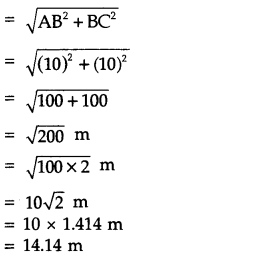
Question 3.
Which of the following is true for displacement?
(a) It cannot be zero
(b) Its magnitude is greater than the distance travelled by the object.
(c) Its magnitude is less than or equal to distance travelled by the object.
Answer:
(c) Its magnitude is less than or equal to distance travelled by the object.
Question 4.
Distinguish between speed and velocity.
Answer:
Distinction between Speed and Velocity:
| Speed | Velocity |
| 1. It is defined as the rate of a change of a position of a body i.e. the distance covered by a body per unit time. | It is defined as the rate of change of displacement of a body. i.e. it is the speed in a particular direction. |
| 2. It is a scalar quantity and can be completely represented by its magnitude only. | It is a vector quantity. To represent it completely it requires both magnitude and direction. |
| 3. Speed of an object is always positive. | Velocity of an object can be both positive and negative. |
Question 5.
Under what condition(s) is the magnitude of average velocity of an object is equal to its average speed?
Answer:
We know, Average speed = Total distance travelled / Total time taken
and Average velocity = Displacement /Total time
When a body travels in a straight line with variable motion in the same direction then total distance covered and displacement are equal in magnitude. In this case the average speed and average velocity are equal.
Question 6.
What does the odometer of an automobile measure?
Answer:
The odometer of an automobile measures the distance covered by it.
Question 7.
What does the path of an object look like when it is in uniform motion?
Answer:
When an object is in uniform motion, it moves along a straight line. But an object can also move with uniform motion along a circular path.
Question 8.
During an experiment, a signal from a spaceship reached the ground station in five minutes. What was the distance of the spaceship from the ground station?The signal travels at a speed of light that is 3 × 10s ms-1.
Solution:
Time taken by the signal to reach the ground station from spaceship (t) = 5 min = 5 × 60 s = 300 s
Speed of Signal (υ) = Speed of light = 3 × 108 ms-1
Distance of the spaceship from earth (s) = ?
Distance of spaceship from ground (s) = speed of signal (υ) × Time (t)
= 3 × 108 × 300
= 3 × 108 × 3 × 102
= 9 × 108 × 102
= 9 × 1010 m
Question 9.
When will you say a body is in:
1. uniform acceleration?
2. non-uniform acceleration?
Answer:
1. Uniform Acceleration. When a body travels in a straight line and its velocity changes by equal amounts in equal intervals of time then it is said to travel with uniform acceleration.
2. Non-Uniform Acceleration. When the velocity of a body changes by unequal amounts in equal intervals of time then the body is said to travel with non-uniform acceleration.
Question 10.
A bus decreases its speed from 80 km h-1 to 60 km h-1 in 5 s. Find the acceleration of the bus.
Solution:
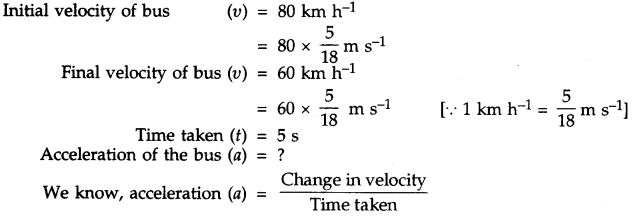
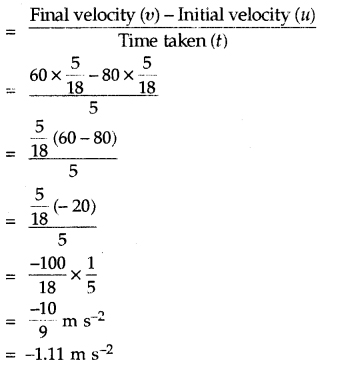
Hence, the bus has negative acceleration (retardation).
Question 11.
A train starting from a railway station and moving with uniform acceleration attains a speed 40 km h-1 in 10 minutes. Find its acceleration.
Solution:
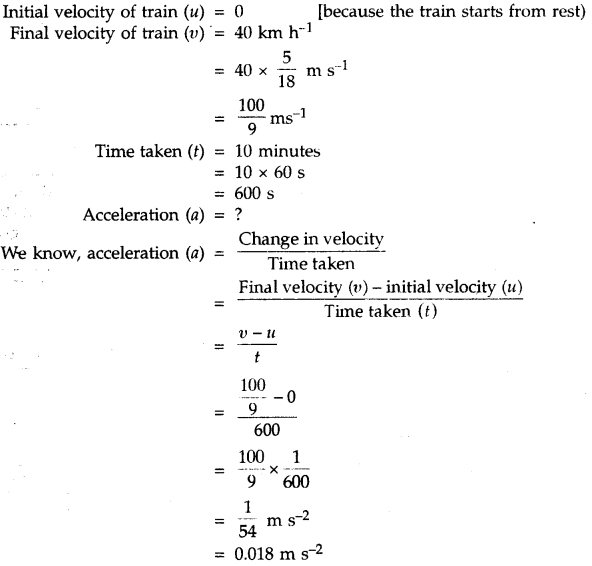
Question 12.
What is the nature of the distance-time graphs (x – t) for uniform and non-uniform motion of an object?
Answer:
When a body covers equal distances in equal intervals of time, then it is said to travel with uniform motion. In this situation, the distance covered by the body is directly proportional to the time taken. Therefore, distance-time (x – t) graph for uniform motion is a straight line.
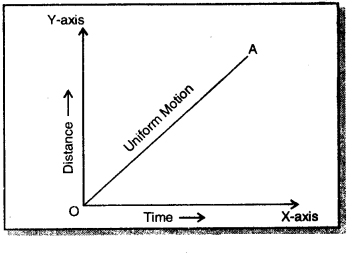
Distance – time (x – t) graph for non-uniform motion may be a curved graph of any shape because a body travels unequal distances in equal intervals of time.
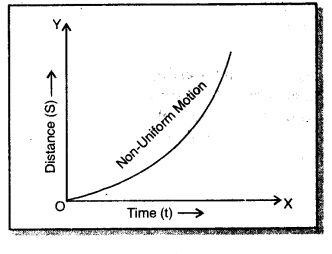
Question 13.
What can you say about the motion of object whose distance – time graph is a straight line parallel to time axis?
Answer:
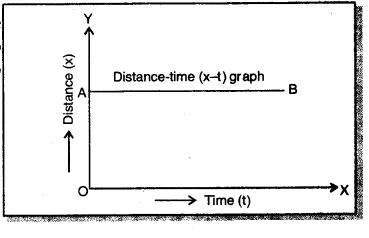
The object whose distance-time (x – t) graph is a straight line parallel to the time axis will be at rest with respect to the surroundings.
Question 14.
What can you say about the motion of an object if its speed-time graph is a straight line parallel to time axis?
Answer:
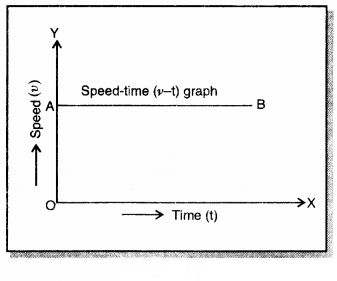
The object whose speed – time (u – t) graph is a straight line parallel to time axis shows that it is in motion with uniform speed.
Question 15.
What is the quantity which is measured by the area occupied below velocity-time graph?
Answer:
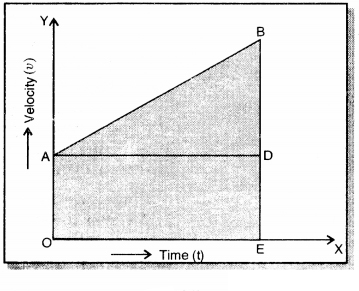
The area occupied below velocity-time graph measures displacement of the body.
Question 16.
A bus starting from rest moves with a uniform acceleration of 0.1 ms-2 for two minutes. Find (a) the speed acquired (b) the distance travelled.
Solution:
(a) Initial speed of the bus (u) = 0 (Starting from Rest)
Acceleration of the bus (a) = 0.1 m s-2
Time taken (t) = 2 minutes
= 2 × 60 s
= 120 s
Final speed of the bus (υ) = ?
Distance travelled by the bus (S) =?
We know, υ = u + at
υ = 0 + 0.1 × 120
υ = 1 × 12
υ = 12 ms-1
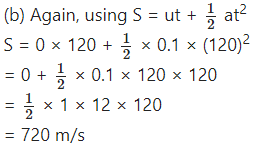
Question 17.
A train is travelling at a speed of 90 km h-1. Brakes are applied so as to produce a uniform acceleration of -0.5 ms-2. Find how far the train will move before it is brought to rest?
Solution:
Initial speed of train (υ) = 90km h-1
= 90 × 5/18 m s-1
= 5 × 5 ms-1
= 25 ms-1
Uniform acceleration (a) = – 0.5m s-2
Final speed of the train (υ) = 0
Distance moved by the train (S) =?
We know, υ2 – u2 = 2as
(0)2 – (25)2 = 2 × (-0.5) × S
– 25 × 25 = -1 × S
∴ S = 625 m
Question 18.
A trolley, while going down an inclined plane has an acceleration of 2 cm s~2. What will be its velocity 3 s after the start?
Solution:
Here initial velocity of trolley (u) = 0 [∵ starting from rest]
Acceleration (a) = 2cm s-2
Time (t) = 3 s
Final velocity of trolley (υ ) = ?
We know, υ = u + at
υ = 0 + 2 × 3
∴ Final velocity of trolley (υ) = 6 cm s-1 Ans.
Question 19.
A racing car has uniform acceleration of 4 ms-2. What distance will it cover in 10 s after start?
Solution:
Acceleration of racing car (a) = 4 ms-2
Initial velocity of racing car (u) = 0
Time (t) = 10 s
Distance covered by the car (S) = ?
We know, S = ut + 1/2at2
S = 0 × 10 + 1/2 × 4 × (10)2
S = 0 + 2 × 10 × 10
∴ Distance covered by racing car (S) = 200 m
Question 20.
A stone is thrown in a vertically upward direction with a velocity of 5 m s-1. If the acceleration of the stone during its motion is 10 m s-2 in the downw ard direction. What will be the height attained by the stone and how much time will it take to reach there?
Solution:
Here, initial velocity (u) = 5 m s-1
Acceleration (a) = – 10 ms-2
[∵ it moves upward against the gravity]
Final velocity of stone (υ) = 0 [At the highest point it is brought to rest]
Height attained (S = h) = ?
Time taken (t) =?
We know,
υ = u + at
0 = 5 + (-10) × t
0 = 5 – 10 × t
10 × t = 5
or t = 5/10
∴ Time taken (t) = 0.5 s
Again, using υ2 – u2 = 2as
(0)2 – (5)2 = 2 × -10 × h
– 5 × 5 = – 20 × h
or h = −25/−20 = 5/4
∴ Height attained (h) – 1.25 m
PSEB 9th Class Science Guide Motion Textbook Questions and Answers
Question 1.
An athelete completes one round of circular track of diameter 200 m in 40 s. What will be the distance covered and the displacement at the end of 2 min 20 s?
Solution:
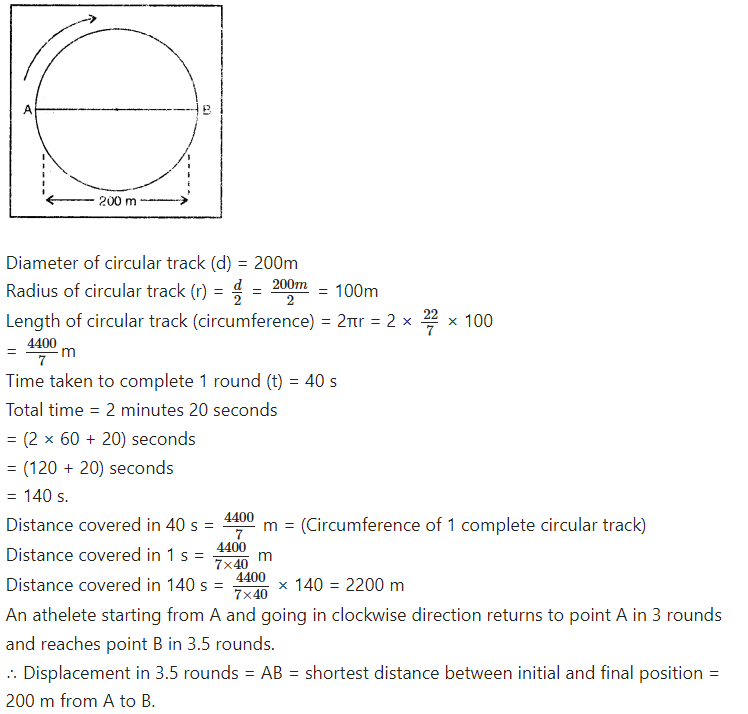
Question 2.
Joseph jogs from end A to the other end B of a straight 300 m road in 2 minutes 50 seconds and then turns around and jogs 100 m back to point C in another 1 minute. What are Joseph’s average speeds and velocities in jogging (a) from A to B (b) from A to C?
Solution:
(a) Length between end point A and end point B (AB) = 300 m
Time taken (t) = 2 min. 30 s
= (2 × 60 + 30) s
= (120 + 30) s
= 150 s.
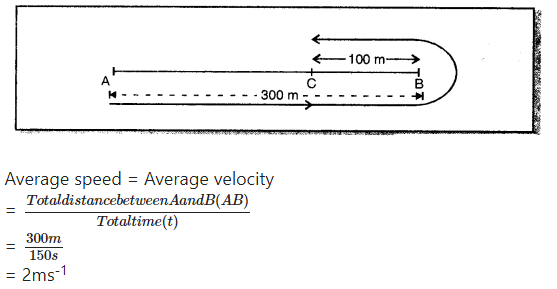
(b) Length from end A to end B + Length on return from B to point C.
= AB + BC
= 300 m + 100 m
= 400 m
Total Time = 2 min 30 s + 1 min
= 3 min 30 s
= (3 × 60 + 30) s
= (180 + 30) s
= 210 s
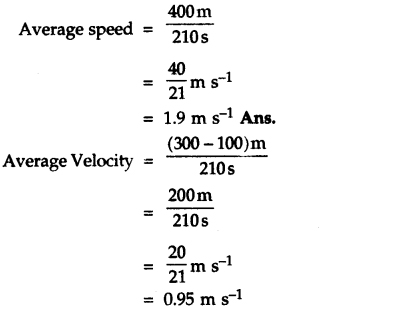
Question 3.
Abdul while driving to school, computes the average speed for his trip to be 20 km h-1. On his trip along the same route, there is less traffic and average speed is 40 km h-1. What is the average speed for Abdul’s trip?
Solution:
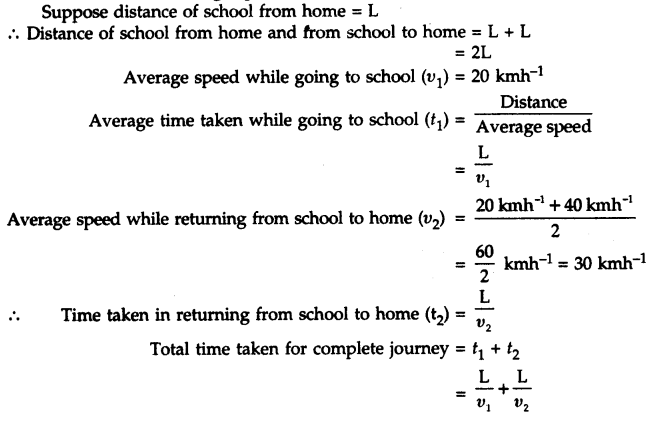
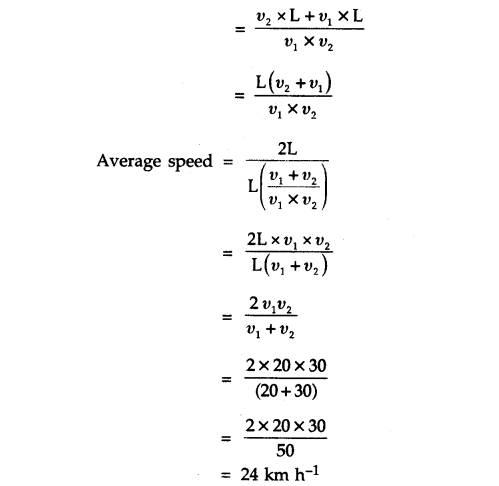
Question 4.
A motorboat starting from rest on a lake accelerates in a straight line at a constant rate of 3.0 m s-2 for 8.0 s. How far does the boat travel during this time?
Solution:
Here, initial velocity of motorboat (u) = 0 [Starting from rest]
Acceleration (a) = 3.0 m s-2
Time (t) = 8.0 s
Distance covered by the motorboat (S) =?

Question 5.
A driver of a car travelling at 52 kmh-1 applies the brakes and accelerates uniformly in opposite direction. The car stops in 5 s. Another driver going at 3 km h-1 applies his brakes slowly and stops in 10 s. On the same graph paper plot the speed versus time graph for the two cars. Which of the two cars travelled farther after the brakes were applied?
Solution:
In the figure AB and CD represent velocity-time graphs of two cars which have their speeds 52 kmh-1 and 30 kmh-1 respectively.
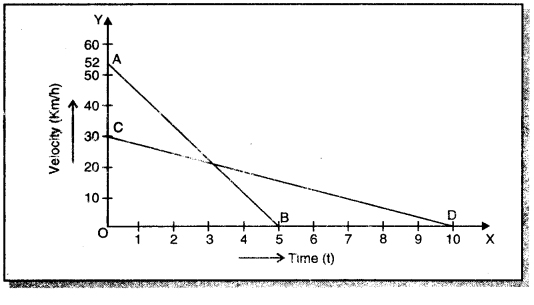
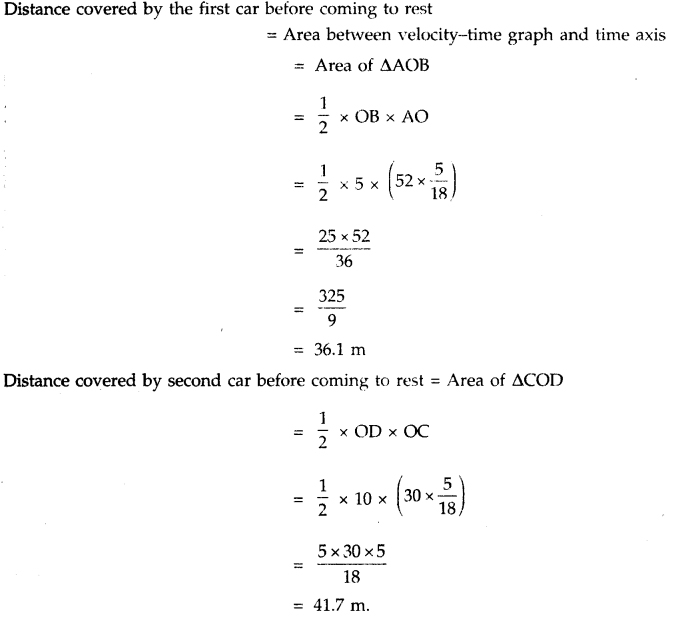
In this way, after applying brakes the second car would cover more distance than the first car.
Question 6.
Fig shows the distance-time graphs of three objects A, B and C. Study the graph and answer the following questions:
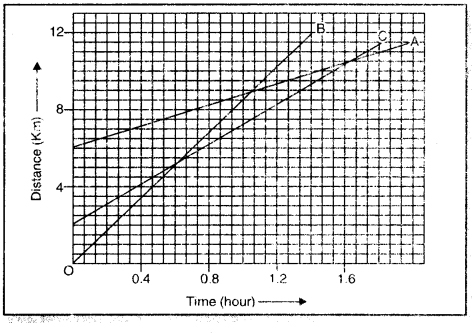
(a) Which of the three is travelling the fastest?
(b) Are all three ever at the same point on the road?
(c) How far has C travelled when B passes A?
(d) How far has B travelled by the time it passes C?
Solution:
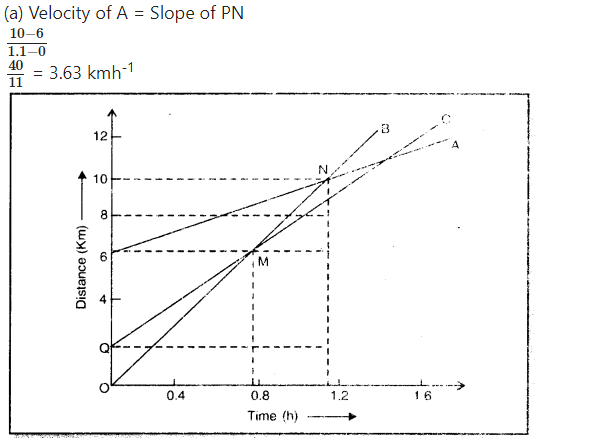
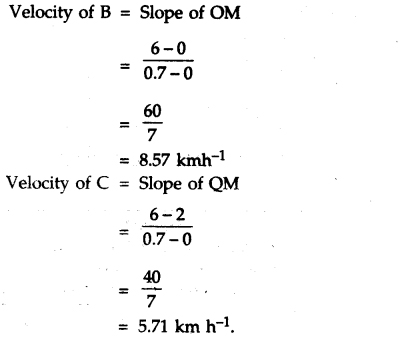
Because slope of object B is maximum of all therefore, it is moving fastest.
(b) Since all the three graphs do not intersect at any point therefore, all the three do not meet ever at the same point on the road.
(c) When the object B passes A at point E (at 1.4 hr) then at that time the object C will be at F i.e. 9.3 km away from the origin O.
(d) B passes C at G after covering 8 km.
Question 7.
A ball is gently dropped from a height of 20 m. If its velocity increases uniformly at the rate of 10 m s-2, with what velocity it will strike the ground?After what time will it strike the ground?
Solution:
u = 0 ms-1
S = 20 m
a = 10 ms-2
υ = ?
t = ?
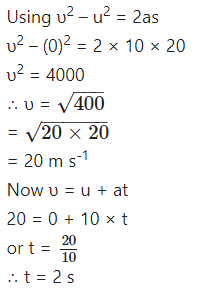
Question 8.
Speed-time graph for a car is shown in the fig.
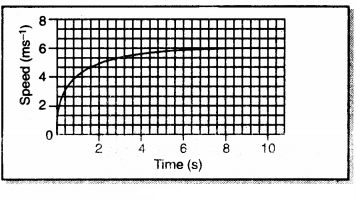
(a) Find how far the car travelled in first 4 s. Shade the area on the graph that represents the distance travelled by car during this period.
(b) Which part of the graph represents uniform motion of the car?
Solution:
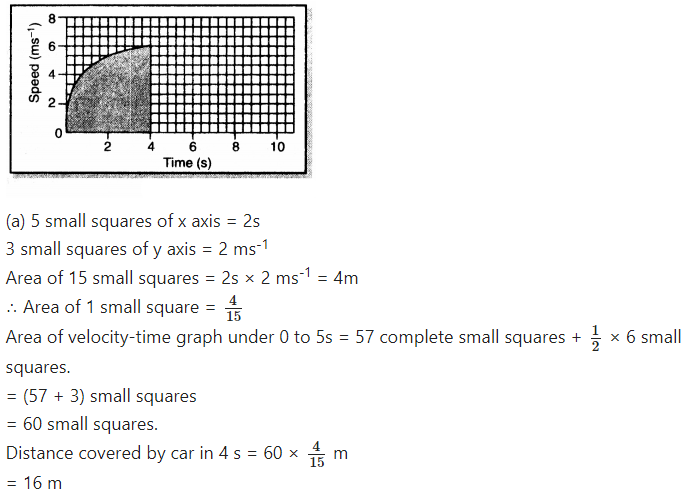
(b) After 6 s the car has uniform motion.
Question 9.
State which of the following situations are possible and give an example for each of these.
(a) an object with a constant acceleration but with zero velocity.
(b) an object moving in a certain direction with an acceleration in the perpendicular direction.
Answer:
(a) Yes, this situation is possible.
Example: When an object is projected upwards, its velocity at the maximum height is zero although acceleration on it is 9.8 ms-2 i.e. equal to g.
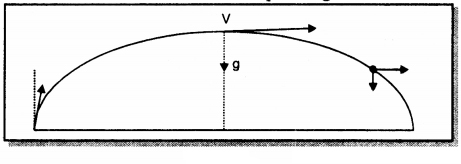
(b) Yes, at the maximum height of projection the velocity is in the horizontal direction and its acceleration is perpendicular to the direction of motion as shown in figure.
Question 10.
An artificial satellite is moving in a circular path orbit of radius 42,250 km. Calculate its speed if it takes 24 hours to revolve around the earth.
Solution:
Radius of circular path of artificial satellite (r) = 42,250 km
Angle formed (subtended) at the centre of earth (θ) = 2π radian
Time taken by the satellite to complete 1 revolution (t) = 24hrs
= 24 × 3600s
= 86400 s
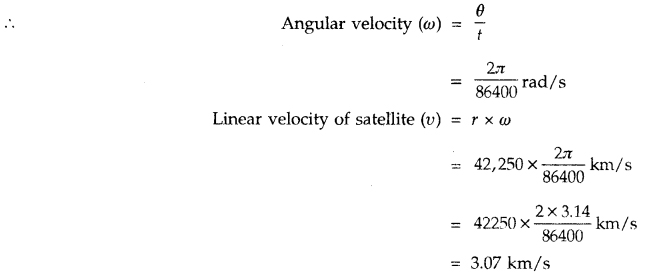
Follow on Facebook page – Click Here
Google News join in – Click Here
Read More Asia News – Click Here
Read More Sports News – Click Here
Read More Crypto News – Click Here